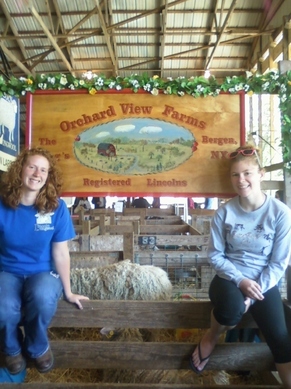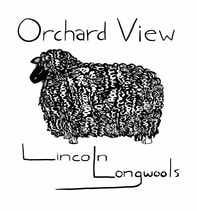 This past weekend was the Maryland Sheep and Wool Festival, as I posted about last time. It is hands-down my favorite weekend of the year. We get to see what everyone else's lambs look like, get to see friends we haven't seen since last fall (or even last year at this show), and just have fun! When I started showing, the shows made me nervous, but I've learned to just relax and have fun with my sheep. We placed about middle of the pack, which is about where we usually are. Our yearling ewes were small this year for whatever reason, and due to our poor lambing season, our ewe lambs were born close to the show cutoff and were small as well. Our yearling ram, Ben, didn't do as well as I had hoped because he was the tallest, longest ram in the ring. But I'm still proud of him and there's always next year! Over the years I've learned that it's not about where you place (that part is totally up to the judge, and would change from one judge to another), as long as you are happy with what your sheep look like. I had the pleasure this weekend of helping Brian Larson, the president of the National Lincoln Breeders Association, prepare his sheep and show. Over the last several years, he has been experimenting with artificial insemination (AI) in his Lincolns. Currently, the success rate for our breed (and most sheep breeds actually) is only about 30-40%, due to sheep's small and complex reproductive system. The process is actually surgical. The only breed of sheep that has successfully been doing AI is the Icelandic breed. This breed was isolated on the island of Iceland for so long that their reproductive systems have evolved differently, and therefore vaginal AI has a 60-80% success rate! Because the process in Lincolns is surgical and does not have a good success rate, it is fairly expensive and not many people have been experimenting with it yet in our breed. The differences that Brian has seen in his AI breed are amazing! The semen he has been using has come from rams in the UK. Here in the U.S. we have a "bigger is better" mentality that definitely comes out in our animal breeding. American Lincolns are much taller and thinner throughout the shoulders; they have lost the "stockiness" of the British sheep. Also through our breeding, we have lost much of the wool's ability to create locks. This is hard to see without comparing his AI sheep to American sheep, and without an understanding of wool. The three AI sheep that he brought to the show were definitely shorter to the ground, but extremely robust throughout the shoulders. Brian shows in full fleece, meaning the yearlings have not been shorn in about a year, but due to their improved wool quality and his clean conditions, the wool is beautiful! He also said that his AI sheep have a much different temperament than American sheep; they are much more curious and laid back.... I guess similar to the Brits themselves! While it is an expensive process, he has been seeing some great results and ended up winning Supreme Champion Ram. (For those of you non-sheep showing people, they choose a top ram and ewe from each breed, and then all the breeds together compete for "best of the best"). Hopefully in the future, I'll have the time and ability to also experiment with this, but in the meantime there's other things I need to work on breeding into my flock! Thanks to Brian for allowing me to help show and for all the knowledge you've passed onto me over the years!
0 Comments
Leave a Reply. |
AuthorEmmaline Long, main owner of Orchard View Farm, has a passion for Lincoln sheep and loves educating others about her breed and farm, She currently serves as the Vice President of the National Lincoln Breeders Association. Archives
October 2020
Categories
All
|
Orchard View Lincoln Longwools7617 S. Lake Rd., Bergen NY 14416 |
Contact UsStay Up-To-DateFollow our blog!
|
